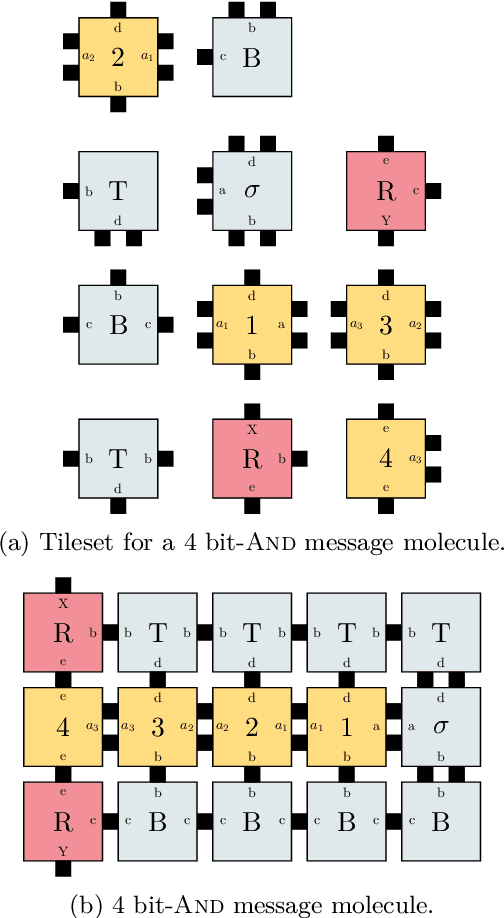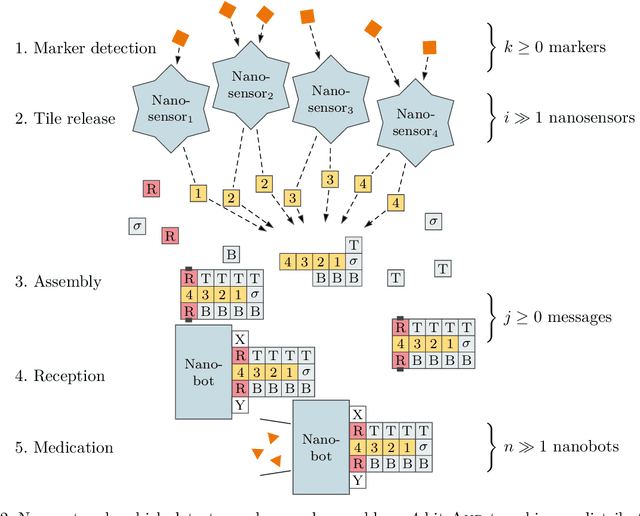Tanya Braun
Lifted Forward Planning in Relational Factored Markov Decision Processes with Concurrent Actions
May 28, 2025Abstract:Decision making is a central problem in AI that can be formalized using a Markov Decision Process. A problem is that, with increasing numbers of (indistinguishable) objects, the state space grows exponentially. To compute policies, the state space has to be enumerated. Even more possibilities have to be enumerated if the size of the action space depends on the size of the state space, especially if we allow concurrent actions. To tackle the exponential blow-up in the action and state space, we present a first-order representation to store the spaces in polynomial instead of exponential size in the number of objects and introduce Foreplan, a relational forward planner, which uses this representation to efficiently compute policies for numerous indistinguishable objects and actions. Additionally, we introduce an even faster approximate version of Foreplan. Moreover, Foreplan identifies how many objects an agent should act on to achieve a certain task given restrictions. Further, we provide a theoretical analysis and an empirical evaluation of Foreplan, demonstrating a speedup of at least four orders of magnitude.
Compression versus Accuracy: A Hierarchy of Lifted Models
May 28, 2025Abstract:Probabilistic graphical models that encode indistinguishable objects and relations among them use first-order logic constructs to compress a propositional factorised model for more efficient (lifted) inference. To obtain a lifted representation, the state-of-the-art algorithm Advanced Colour Passing (ACP) groups factors that represent matching distributions. In an approximate version using $\varepsilon$ as a hyperparameter, factors are grouped that differ by a factor of at most $(1\pm \varepsilon)$. However, finding a suitable $\varepsilon$ is not obvious and may need a lot of exploration, possibly requiring many ACP runs with different $\varepsilon$ values. Additionally, varying $\varepsilon$ can yield wildly different models, leading to decreased interpretability. Therefore, this paper presents a hierarchical approach to lifted model construction that is hyperparameter-free. It efficiently computes a hierarchy of $\varepsilon$ values that ensures a hierarchy of models, meaning that once factors are grouped together given some $\varepsilon$, these factors will be grouped together for larger $\varepsilon$ as well. The hierarchy of $\varepsilon$ values also leads to a hierarchy of error bounds. This allows for explicitly weighing compression versus accuracy when choosing specific $\varepsilon$ values to run ACP with and enables interpretability between the different models.
Approximate Lifted Model Construction
Apr 29, 2025



Abstract:Probabilistic relational models such as parametric factor graphs enable efficient (lifted) inference by exploiting the indistinguishability of objects. In lifted inference, a representative of indistinguishable objects is used for computations. To obtain a relational (i.e., lifted) representation, the Advanced Colour Passing (ACP) algorithm is the state of the art. The ACP algorithm, however, requires underlying distributions, encoded as potential-based factorisations, to exactly match to identify and exploit indistinguishabilities. Hence, ACP is unsuitable for practical applications where potentials learned from data inevitably deviate even if associated objects are indistinguishable. To mitigate this problem, we introduce the $\varepsilon$-Advanced Colour Passing ($\varepsilon$-ACP) algorithm, which allows for a deviation of potentials depending on a hyperparameter $\varepsilon$. $\varepsilon$-ACP efficiently uncovers and exploits indistinguishabilities that are not exact. We prove that the approximation error induced by $\varepsilon$-ACP is strictly bounded and our experiments show that the approximation error is close to zero in practice.
Combining Local Symmetry Exploitation and Reinforcement Learning for Optimised Probabilistic Inference -- A Work In Progress
Mar 11, 2025Abstract:Efficient probabilistic inference by variable elimination in graphical models requires an optimal elimination order. However, finding an optimal order is a challenging combinatorial optimisation problem for models with a large number of random variables. Most recently, a reinforcement learning approach has been proposed to find efficient contraction orders in tensor networks. Due to the duality between graphical models and tensor networks, we adapt this approach to probabilistic inference in graphical models. Furthermore, we incorporate structure exploitation into the process of finding an optimal order. Currently, the agent's cost function is formulated in terms of intermediate result sizes which are exponential in the number of indices (i.e., random variables). We show that leveraging specific structures during inference allows for introducing compact encodings of intermediate results which can be significantly smaller. By considering the compact encoding sizes for the cost function instead, we enable the agent to explore more efficient contraction orders. The structure we consider in this work is the presence of local symmetries (i.e., symmetries within a model's factors).
Estimating Causal Effects in Partially Directed Parametric Causal Factor Graphs
Nov 11, 2024Abstract:Lifting uses a representative of indistinguishable individuals to exploit symmetries in probabilistic relational models, denoted as parametric factor graphs, to speed up inference while maintaining exact answers. In this paper, we show how lifting can be applied to causal inference in partially directed graphs, i.e., graphs that contain both directed and undirected edges to represent causal relationships between random variables. We present partially directed parametric causal factor graphs (PPCFGs) as a generalisation of previously introduced parametric causal factor graphs, which require a fully directed graph. We further show how causal inference can be performed on a lifted level in PPCFGs, thereby extending the applicability of lifted causal inference to a broader range of models requiring less prior knowledge about causal relationships.
Lifted Causal Inference in Relational Domains
Mar 15, 2024



Abstract:Lifted inference exploits symmetries in probabilistic graphical models by using a representative for indistinguishable objects, thereby speeding up query answering while maintaining exact answers. Even though lifting is a well-established technique for the task of probabilistic inference in relational domains, it has not yet been applied to the task of causal inference. In this paper, we show how lifting can be applied to efficiently compute causal effects in relational domains. More specifically, we introduce parametric causal factor graphs as an extension of parametric factor graphs incorporating causal knowledge and give a formal semantics of interventions therein. We further present the lifted causal inference algorithm to compute causal effects on a lifted level, thereby drastically speeding up causal inference compared to propositional inference, e.g., in causal Bayesian networks. In our empirical evaluation, we demonstrate the effectiveness of our approach.
Colour Passing Revisited: Lifted Model Construction with Commutative Factors
Sep 20, 2023



Abstract:Lifted probabilistic inference exploits symmetries in a probabilistic model to allow for tractable probabilistic inference with respect to domain sizes. To apply lifted inference, a lifted representation has to be obtained, and to do so, the so-called colour passing algorithm is the state of the art. The colour passing algorithm, however, is bound to a specific inference algorithm and we found that it ignores commutativity of factors while constructing a lifted representation. We contribute a modified version of the colour passing algorithm that uses logical variables to construct a lifted representation independent of a specific inference algorithm while at the same time exploiting commutativity of factors during an offline-step. Our proposed algorithm efficiently detects more symmetries than the state of the art and thereby drastically increases compression, yielding significantly faster online query times for probabilistic inference when the resulting model is applied.
DPM: Clustering Sensitive Data through Separation
Jul 06, 2023Abstract:Privacy-preserving clustering groups data points in an unsupervised manner whilst ensuring that sensitive information remains protected. Previous privacy-preserving clustering focused on identifying concentration of point clouds. In this paper, we take another path and focus on identifying appropriate separators that split a data set. We introduce the novel differentially private clustering algorithm DPM that searches for accurate data point separators in a differentially private manner. DPM addresses two key challenges for finding accurate separators: identifying separators that are large gaps between clusters instead of small gaps within a cluster and, to efficiently spend the privacy budget, prioritising separators that split the data into large subparts. Using the differentially private Exponential Mechanism, DPM randomly chooses cluster separators with provably high utility: For a data set $D$, if there is a wide low-density separator in the central $60\%$ quantile, DPM finds that separator with probability $1 - \exp(-\sqrt{|D|})$. Our experimental evaluation demonstrates that DPM achieves significant improvements in terms of the clustering metric inertia. With the inertia results of the non-private KMeans++ as a baseline, for $\varepsilon = 1$ and $\delta=10^{-5}$ DPM improves upon the difference to the baseline by up to $50\%$ for a synthetic data set and by up to $62\%$ for a real-world data set compared to a state-of-the-art clustering algorithm by Chang and Kamath.
Lifting DecPOMDPs for Nanoscale Systems -- A Work in Progress
Oct 18, 2021

Abstract:DNA-based nanonetworks have a wide range of promising use cases, especially in the field of medicine. With a large set of agents, a partially observable stochastic environment, and noisy observations, such nanoscale systems can be modelled as a decentralised, partially observable, Markov decision process (DecPOMDP). As the agent set is a dominating factor, this paper presents (i) lifted DecPOMDPs, partitioning the agent set into sets of indistinguishable agents, reducing the worst-case space required, and (ii) a nanoscale medical system as an application. Future work turns to solving and implementing lifted DecPOMDPs.
Exploring Unknown Universes in Probabilistic Relational Models
Jan 07, 2020


Abstract:Large probabilistic models are often shaped by a pool of known individuals (a universe) and relations between them. Lifted inference algorithms handle sets of known individuals for tractable inference. Universes may not always be known, though, or may only described by assumptions such as "small universes are more likely". Without a universe, inference is no longer possible for lifted algorithms, losing their advantage of tractable inference. The aim of this paper is to define a semantics for models with unknown universes decoupled from a specific constraint language to enable lifted and thereby, tractable inference.
* Also accepted at the 9th StarAI Workshop at AAAI-20
 Add to Chrome
Add to Chrome Add to Firefox
Add to Firefox Add to Edge
Add to Edge